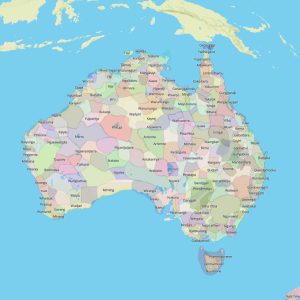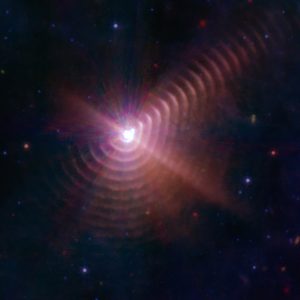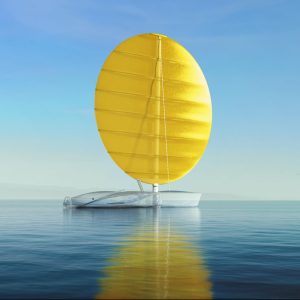Link About It: This Week’s Picks
A cosmic fingerprint, cooling with terracotta, a map explaining what Indigenous territory you’re on and more

Oakland to Return Park Land to Indigenous People
 Oakland, California is slated to become one of the first US cities to return land to Indigenous people—and the first to do so for a federally unrecognized tribe. The city council is planning to rematriate Sequoia Point—a five-acre park owned by the city—to the Sogorea Te’ Land Trust, the East Bay Ohlone tribe and the Confederated Villages of Lisjan Nation for their immediate use in education, natural resources, cultural practices and more. While the five acres do not make up for the displacement and violence wrought upon Indigenous people, it serves as a model for other cities working to return land with greater autonomy—a particularly significant achievement as the first city to do so, Eureka, California, returned land only as a federal trust. This victory may be a first step, but it remains crucial. Learn more about it at USA Today.
Oakland, California is slated to become one of the first US cities to return land to Indigenous people—and the first to do so for a federally unrecognized tribe. The city council is planning to rematriate Sequoia Point—a five-acre park owned by the city—to the Sogorea Te’ Land Trust, the East Bay Ohlone tribe and the Confederated Villages of Lisjan Nation for their immediate use in education, natural resources, cultural practices and more. While the five acres do not make up for the displacement and violence wrought upon Indigenous people, it serves as a model for other cities working to return land with greater autonomy—a particularly significant achievement as the first city to do so, Eureka, California, returned land only as a federal trust. This victory may be a first step, but it remains crucial. Learn more about it at USA Today.
Image courtesy of Oakland Mayor’s Office
Francis Kéré’s New Evolving Playground in Kampala, Uganda
 On 14 October, a new playground in Kampala, Uganda from Burkina Faso-born, Pritzker Prize-winner Francis Kéré will open. Like all of the architect’s work, the playground weaves the needs, desires, hopes and life of the community within its design. The project—which began as a simple place to play—is now a multipurpose complex with space for workshops, night classes, open-air areas, a gym, internet café, music studio and multi-sport pitch. Kéré spoke with locals to understand the area, leading him to implement crucial details like blank canvases for graffiti artists and butterfly roofs that offer respite from the sun while providing enough ventilation for sports and recreation. Nestled between zigzagging alleys, the complex’s array of shady areas for dancing and gathering is inspired by palaver trees in West Africa which commonly act as a site for community meetings. Learn more about his spirited, hospitable project at Architectural Digest.
On 14 October, a new playground in Kampala, Uganda from Burkina Faso-born, Pritzker Prize-winner Francis Kéré will open. Like all of the architect’s work, the playground weaves the needs, desires, hopes and life of the community within its design. The project—which began as a simple place to play—is now a multipurpose complex with space for workshops, night classes, open-air areas, a gym, internet café, music studio and multi-sport pitch. Kéré spoke with locals to understand the area, leading him to implement crucial details like blank canvases for graffiti artists and butterfly roofs that offer respite from the sun while providing enough ventilation for sports and recreation. Nestled between zigzagging alleys, the complex’s array of shady areas for dancing and gathering is inspired by palaver trees in West Africa which commonly act as a site for community meetings. Learn more about his spirited, hospitable project at Architectural Digest.
Image courtesy of Iwan Baan
Electricity-Free Air Conditioning, Powered by Terracotta
 Created by Yael Issacharov, the Nave Air Conditioning system is a wall made from terracotta that can cool a room without electricity. The design is inspired by jarrah, a traditional Palestinian drinking water container (made from the same material) that is hung to cool the water and living space. Because clay is porous, water filters out through the pores and evaporates via the heat from the water. As this happens, heat transfers out of the water, cooling the material and thus the room at large. Issacharov utilizes this phenomenon by turning the jarrah into modular, active walls that hold water. Scalable and locally resourced, the sustainable system can get any room to around 77 degrees Fahrenheit and 30-70% humidity, including in the desert where it works especially well. Learn more about the clever system at Fast Company.
Created by Yael Issacharov, the Nave Air Conditioning system is a wall made from terracotta that can cool a room without electricity. The design is inspired by jarrah, a traditional Palestinian drinking water container (made from the same material) that is hung to cool the water and living space. Because clay is porous, water filters out through the pores and evaporates via the heat from the water. As this happens, heat transfers out of the water, cooling the material and thus the room at large. Issacharov utilizes this phenomenon by turning the jarrah into modular, active walls that hold water. Scalable and locally resourced, the sustainable system can get any room to around 77 degrees Fahrenheit and 30-70% humidity, including in the desert where it works especially well. Learn more about the clever system at Fast Company.
Image by Francesco m Lucini/courtesy Yael Issacharov
Native Land Digital’s Map Shows What Indigenous Territory You’re On
 Canadian non-profit Native Land Digital (mostly funded by the Kalliopeia Foundation) is an Indigenous-led organization that runs Native-Land.ca—a searchable online map that shows Native territories, nations, languages and treaties. Users can search with “settler names” on or off, and when an Indigenous label is clicked, a link appears which leads to extra reading, images and related maps. While some countries are more populated than others in terms of labels and related content, the map and the organization as a whole aim to “improve the relationship of people—both Indigenous and non-Indigenous—with the history and sacredness of the land around them.” Read more at NPR.
Canadian non-profit Native Land Digital (mostly funded by the Kalliopeia Foundation) is an Indigenous-led organization that runs Native-Land.ca—a searchable online map that shows Native territories, nations, languages and treaties. Users can search with “settler names” on or off, and when an Indigenous label is clicked, a link appears which leads to extra reading, images and related maps. While some countries are more populated than others in terms of labels and related content, the map and the organization as a whole aim to “improve the relationship of people—both Indigenous and non-Indigenous—with the history and sacredness of the land around them.” Read more at NPR.
Image from Native-Land.ca
“Cosmic Fingerprint” Captured by James Webb Telescope
 Emanated by the duo of stars called the Wolf-Rayet 140 system, 17 dust rings thousands of light years away have been captured by the James Webb Telescope. The image of these concentric dust loops is stunning, and resembles a “cosmic fingerprint” which has been created because “wind from the other star sweeps the gas into lanes and you have enough of the material close together that it condenses into dust,” explains Dr Olivia Jones—Webb fellow at the UK Astronomy Technology Centre. “Not only is this a spectacular image but this rare phenomenon reveals new evidence about cosmic dust and how it can survive in the harsh space environments.” Find out more at The Guardian.
Emanated by the duo of stars called the Wolf-Rayet 140 system, 17 dust rings thousands of light years away have been captured by the James Webb Telescope. The image of these concentric dust loops is stunning, and resembles a “cosmic fingerprint” which has been created because “wind from the other star sweeps the gas into lanes and you have enough of the material close together that it condenses into dust,” explains Dr Olivia Jones—Webb fellow at the UK Astronomy Technology Centre. “Not only is this a spectacular image but this rare phenomenon reveals new evidence about cosmic dust and how it can survive in the harsh space environments.” Find out more at The Guardian.
Image courtesy of NASA, ESA, CSA, STScI, JPL-Caltech
Sustainable Materials Form The “Second Sun” Speculative Sailboat
 From São Paulo, Brazil-based Furf Design Studio and designer Cesar Pieri, the “Second Sun” sailboat concept minimizes environmental impact twofold: technically and aesthetically. First, the boat is crafted with sustainable materials, including a hull developed from an algae-based biopolymer and sails from ocean-bound plastic. Second, the transparent design of the ship allows a deeper connection between sailor and sea—and the circular shape of its sail emulates nature. Read more about the speculative vessel at designboom.
From São Paulo, Brazil-based Furf Design Studio and designer Cesar Pieri, the “Second Sun” sailboat concept minimizes environmental impact twofold: technically and aesthetically. First, the boat is crafted with sustainable materials, including a hull developed from an algae-based biopolymer and sails from ocean-bound plastic. Second, the transparent design of the ship allows a deeper connection between sailor and sea—and the circular shape of its sail emulates nature. Read more about the speculative vessel at designboom.
Image courtesy of Furf Design Studio
Link About It is our filtered look at the web, shared daily in Link and on social media, and rounded up every Saturday morning. Hero image courtesy of Furf Design Studio












